
Greywater wetland in action
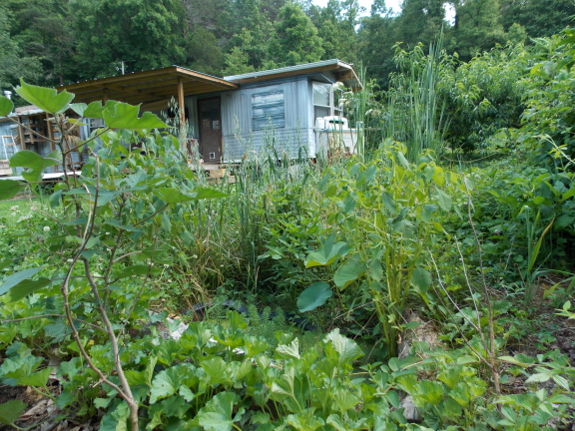
One of our fun
projects this past winter was creating a greywater wetland to deal
with the water coming out of our kitchen sink. You can read
more about the wetland by following the links below:
- Inspiration
for the wetland. (Be sure to follow the links at the
bottom of the post for the rest of the lunchtime series.)
- Planning the wetland
- Digging out the wetland area
- Planning the pipes
- Rocking in the inlet to prevent erosion
- Installing the pipes
- More
on the pipes (and pond)
- Greywater wetland's first inundation
- Plans
for the future
So far, the wetland
has been quite effective, although it has the usual growing
pains. I'll show you what's working (and what's not) below.
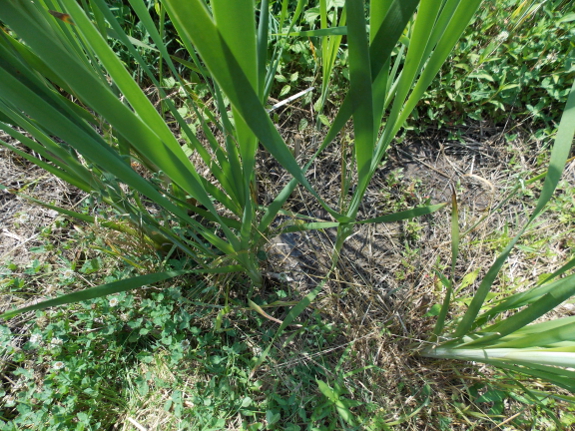
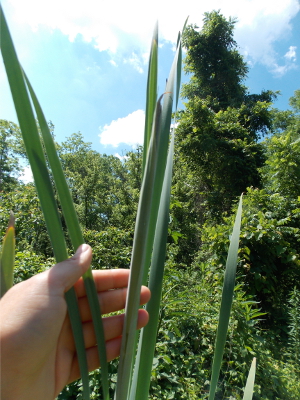 The water from our kitchen sink is enough to
keep the area where I planted cattails (just below the inlet)
sodden. This has resulted in very happy plants, one of which
is putting up a flowering spike. I'm ultra-excited about the
spike because I've wanted to taste cattail flowers ever since Eric
blogged about them, but I'm too busy at this time of year to make weekly trips
to the wetland up the holler to check on the cattails'
progress. This year, we'll definitely get to taste at least
one cattail flower!
The water from our kitchen sink is enough to
keep the area where I planted cattails (just below the inlet)
sodden. This has resulted in very happy plants, one of which
is putting up a flowering spike. I'm ultra-excited about the
spike because I've wanted to taste cattail flowers ever since Eric
blogged about them, but I'm too busy at this time of year to make weekly trips
to the wetland up the holler to check on the cattails'
progress. This year, we'll definitely get to taste at least
one cattail flower!
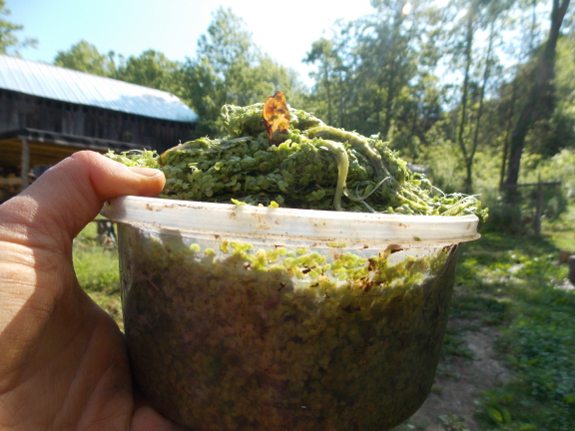
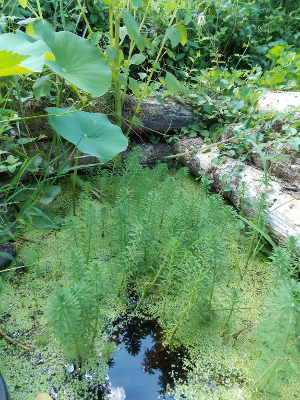 The pond is also doing very well, and has already produced
half a gallon of duckweed for the garden. Too bad our
chickens still won't eat the stuff.... If we had a much larger pond,
though, I could see harvesting duckweed to use as a high-nitrogen
mulch around seedlings.
The pond is also doing very well, and has already produced
half a gallon of duckweed for the garden. Too bad our
chickens still won't eat the stuff.... If we had a much larger pond,
though, I could see harvesting duckweed to use as a high-nitrogen
mulch around seedlings.
You'll notice I also
installed a Chinese lotus in the little pond (which is just barely
deep and large enough to keep such a hefty plant happy). The
inspiration for the lotus came from Paradise Lot, whose author explains
that the seeds produced by lotuses are large, tasty nuts.
(I'll admit that lotuses are also one of the few ornamental plants
I just love and would install without a use.)
The one failed
experiment related to the pond is the mushroom logs serving as a
retaining wall on the banks. While the logs work well and do
help anchor the pond visually, they weren't shaded enough, so the
bark dried up and flaked off, killing the fungi. This
experiment might have worked if I'd had the shrubs established on
the retaining wall a year before adding the mushroom logs, but
shouldn't be repeated as-is.
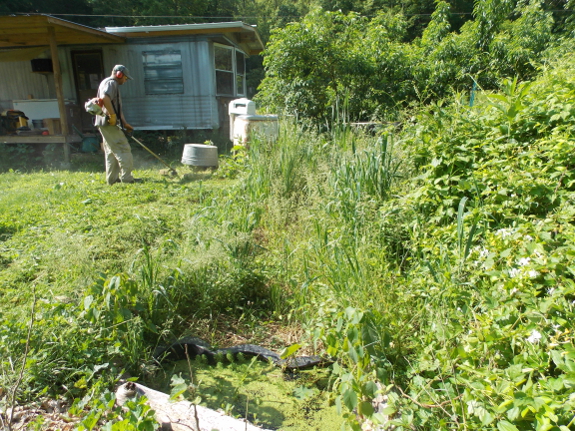
Another factor to
consider if you're replicating our design is maintenance.
Without a weedeater, it would be much tougher to keep the
irregular edges of the wetland in line, but, luckily, Mark is a
pro at cutting exactly where I ask him to. (This is a trait
to put on your list for World's Best Permaculture Husband, in case
you're still single.)
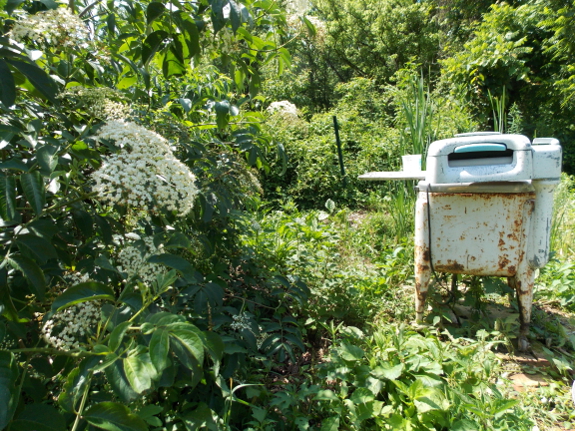
Okay, this picture
isn't really informative, but I love the elderberry flowers and
our wringer washer together.
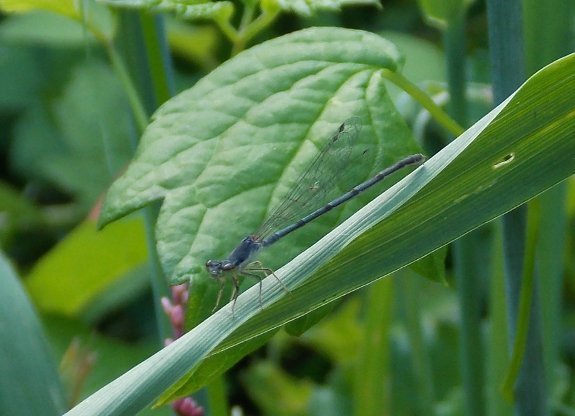
And, speaking of
beauty, the pond is attracting lots of fascinating (and useful)
life, like the damselfly above. A frog has also taken up
residence, and a large black rat snake slithered away when I
approached to take photos.
Okay, I can hear you
saying, but what about the primary purpose of the wetland ---
dealing with greywater? On the plus side, we no longer have
a swamp in the path outside our back door, and the wetland itself
doesn't seem to have any odor or to attract Lucy's
attention. However, in the last month, we've noticed a
swampy smell wafting up the pipes into the kitchen sink.
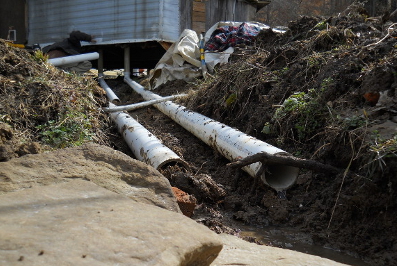 Oddly enough, we never had a smell problem
from our much lower-tech drain-out-back, which makes me think
the issue is that I didn't get the junction between the ten-foot
pieces of pipe completely level. If that area dipped down,
food scraps (or just nutrient-rich water) could collect there and
rot anaerobically, creating the swampy smell.
Oddly enough, we never had a smell problem
from our much lower-tech drain-out-back, which makes me think
the issue is that I didn't get the junction between the ten-foot
pieces of pipe completely level. If that area dipped down,
food scraps (or just nutrient-rich water) could collect there and
rot anaerobically, creating the swampy smell.
The short-term
solution seems to be leaving the strainers in the sink, which
blocks nearly all the smell. In the longer-run, our first
fix attempt will be to hook up at least one of the gutter outlets
to each of the greywater lines (as originally planned) so heavy
rains will flush out any pockets of food. If that fails, we
can always add a trap to our sink drains as
Dirk suggested,
which should block any smell from wafting back into the house.
That small problem
aside, we wholly recommend the greywater wetland for those of you
living in climates with cold winters and plenty of rain. If
you want to put the greywater to more use (and don't have freezing
winters), you might instead check out mulch
basins.
But, whatever you do, don't waste energy by sending greywater down
the drain into a sewage system!
Want more in-depth information? Browse through our books.
Or explore more posts by date or by subject.
About us: Anna Hess and Mark Hamilton spent over a decade living self-sufficiently in the mountains of Virginia before moving north to start over from scratch in the foothills of Ohio. They've experimented with permaculture, no-till gardening, trailersteading, home-based microbusinesses and much more, writing about their adventures in both blogs and books.
Want to be notified when new comments are posted on this page? Click on the RSS button after you add a comment to subscribe to the comment feed, or simply check the box beside "email replies to me" while writing your comment.

Having some plumbing experience, I can't imagine getting away with not using a P trap. Black anerobic horror will build up even on verticle sections of pipe. My advice is just add the P trap and be done with it, the pvc ones are only a few dollars. You don't want to be breathing the gasses from that stuff, even at levels you can't smell.
The wetland is awesome, I am totally jealous. Maybe next year we will get one together. Thank you for sharing, and for conserving water.
How were the cattail flowers? I've also read you can eat the roots and shoots.
Are the lotus nuts good? What do they taste like?